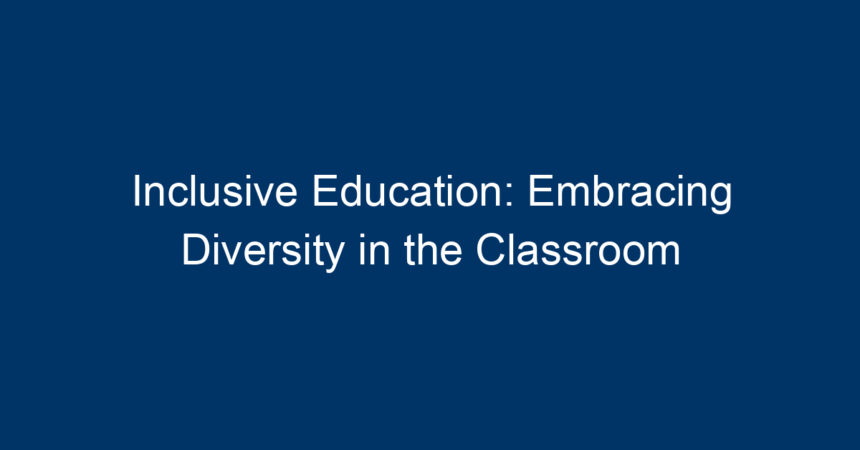In today’s interconnected and multicultural society, the importance of inclusive education cannot be overstated. This powerful approach to teaching not only enhances learning outcomes for all students but also prepares them to thrive in a diverse environment. In this article, we will explore the significance of inclusive education, its key principles, strategies for implementation, and the impact it has on students and the wider community. By integrating the concept of inclusivity into classrooms, educators can create an environment that embraces diversity and fosters equity.
The Essence of Inclusive Education
Inclusive education is defined as a teaching philosophy that promotes the full participation of all students in the learning process, regardless of their backgrounds, abilities, or needs. It is grounded in the belief that every learner has the right to access quality education, with appropriate support systems in place.
The Importance of Embracing Diversity
Embracing diversity in the classroom enriches the educational experience. Different perspectives, cultural backgrounds, and learning styles create an atmosphere of collaboration and respect. Students in inclusive settings learn empathy, communication, and problem-solving skills as they interact with peers who may be different from themselves.
Inclusive education prepares students for a globalized world where they will encounter individuals from various backgrounds. It instills values of tolerance, acceptance, and appreciation of differences, which are vital for fostering harmonious communities.
Key Principles of Inclusive Education
1. Equal Access to Learning
One of the foundational principles of inclusive education is the right to equal access for all students. This means creating adaptable learning environments that cater to diverse learning needs. For instance, resources such as audiobooks, visual aids, and technology can be integrated into the curriculum to assist students with different learning styles.
2. High Expectations for All
Teachers should maintain high expectations for every student, regardless of their abilities. Research shows that believing in a student’s potential can significantly impact their performance. Setting challenging but achievable goals encourages students to push their boundaries and strive for success.
3. Collaborative Learning
Collaboration is at the heart of inclusive education. Students should be encouraged to work together on projects, share ideas, and support one another. Group activities foster a sense of community and belonging, enabling students to learn from each other’s strengths and perspectives.
4. Individualized Support
Understanding that each student has unique needs is crucial for implementing inclusive education. Tailored support mechanisms like Individualized Education Plans (IEPs) provide the structure needed for students to succeed. Educators should work closely with parents, specialists, and the students themselves to create these personalized plans.
Strategies for Implementing Inclusive Education
1. Professional Development for Educators
For inclusive education to thrive, teachers must be equipped with the skills and knowledge to accommodate diverse learners. Ongoing professional development programs focused on inclusive teaching strategies are essential. Workshops and training sessions can help educators explore new methodologies, tools, and resources that promote inclusivity.
2. Creating an Inclusive Curriculum
The curriculum should reflect the diversity of the student body, incorporating multicultural perspectives and voices. When students see themselves represented in the material they study, it boosts their confidence and fosters a sense of belonging. Designing lessons that celebrate different cultures, histories, and experiences is vital for student engagement.
3. Supporting Mental and Emotional Well-being
Inclusive education goes beyond academic achievements; it also emphasizes the importance of mental and emotional health. Creating a supportive environment where students feel safe to express themselves allows for better learning outcomes. Schools can introduce counseling services, peer support groups, and mindfulness practices to nurture emotional well-being.
4. Involving Families and Communities
Inclusive education should extend beyond the classroom; it requires collaboration with families and the community. Schools can hold workshops and information sessions to educate parents about inclusive practices and encourage their involvement in school activities. Engaging the community amplifies the supportive network available to students, fostering a sense of belonging.
The Challenges of Inclusive Education
1. Resistance to Change
While the benefits of inclusive education are clear, resistance to change can be a significant barrier. Some educators may feel unprepared or uncertain about adapting their teaching methods. Addressing these concerns through training and open dialogue will help smooth the transition toward inclusion.
2. Resource Limitations
Implementing inclusive education can be resource-intensive. Schools may face challenges related to funding, staffing, and access to specialized programs. Advocating for equitable funding and resource allocation is crucial for ensuring all students can benefit from high-quality inclusive education.
3. Overcoming Stereotypes
Stereotypes about students with disabilities or different backgrounds can create obstacles for inclusive education. Combating these preconceived notions requires dedicated efforts to educate both staff and students about diversity and inclusivity. Fostering an environment free from bias is essential for creating a successful inclusive classroom.
The Impact of Inclusive Education
1. Enhanced Academic Outcomes
Studies have shown that inclusive education leads to improved learning outcomes for both students with and without disabilities. By fostering collaboration and peer learning, students develop critical thinking skills and gain a deeper understanding of the subject matter.
2. Building Social Skills and Emotional Intelligence
In an inclusive setting, students develop valuable social skills as they interact with diverse peers. They learn to communicate effectively, resolve conflicts, and empathize with others. These experiences contribute to stronger emotional intelligence, which is essential for personal and professional success.
3. A More Inclusive Society
Ultimately, the benefits of inclusive education ripple beyond the classroom. When students are taught to embrace diversity, they carry these values into their communities. This collective shift towards acceptance and understanding can lead to a more inclusive society, where everyone is valued and respected.
Actionable Insights for Educators
-
Reflect on Your Teaching Practices: Regularly assess your teaching methods to identify areas for improvement. Seek feedback from colleagues and students to enhance inclusivity in your classroom.
-
Foster Relationships: Build strong, trusting relationships with your students. Create a classroom environment that encourages open dialogue and mutual respect.
-
Utilize Technology: Leverage technology to support diverse learning needs. Explore educational apps and tools designed to make learning more accessible.
-
Create an Inclusive Classroom Environment: Use visual aids, flexible seating arrangements, and diverse literature to create a welcoming atmosphere for all students.
- Engage with the Community: Collaborate with local organizations and families to enrich the educational experience and strengthen the support network around each student.
Conclusion
Inclusive education is not just an educational policy; it’s a transformative approach that embraces diversity in the classroom. By prioritizing equal access, high expectations, and individualized support, educators can create an enriching learning environment that benefits all students. Embracing inclusive education requires dedication, collaboration, and a commitment to continuous improvement. Through these efforts, we can nurture a generation of empathetic, engaged citizens ready to flourish in an inclusive society.
By adopting these insights, educators can take meaningful steps toward fostering inclusive education, ultimately leading to a more equitable and harmonious world for all.




